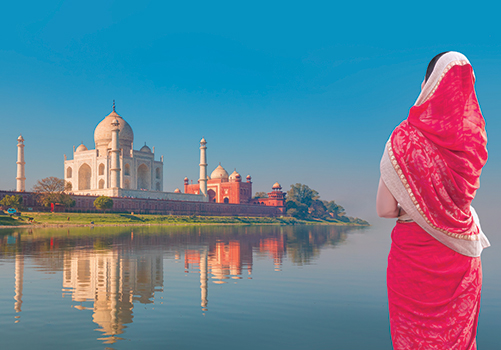
A special day was around the corner for a 15-year-old girl. The “Tenth Grade Farewell Party†held a couple of decades ago was the highlight of her graduating class as it marked the completion of “school life†and transition to the very grown-up world of “college life.†Celebrating this milestone meant dressing to the nines, dancing the night away and tearful goodbyes to favorite teachers and friends who had shared the classroom with her since kindergarten. A cocktail of emotions was swirling within her and among the many reasons for the excitement was wearing a saree to the farewell party.
I was that girl and I am talking about what ignited my infatuation with sarees. Being wrapped in the luxury of my sister’s magenta colored chiffon, I felt like a dream had come true. Enchanted by its beauty, I even failed to notice my less than perfect make up. What I thought would be just a spring fling gradually blossomed into romance.
If I had to guess, I was draped in a miniature saree for the first time at my annaprasan – the first feeding of rice considered the earliest rite of passage for a Bengali baby. Like most infants, I probably threw a fit and tried to pull out the embellishments from the fabric or protested by scratching wildly. By the time I was a teenager, I had worn sarees as costumes but never as an attire of choice.
I have immense admiration for previous generations of women whose wardrobes consisted exclusively of sarees. Elegantly draped, with flowing pallus, saree clad actresses regaled the audience on the silver screen before Western attire was commonly accepted in India. I would watch in awe as my mother and aunts put on their sarees in the traditional Bengali atpoure style without the help of a mirror and often wondered how my sisters could manage to keep their aanchal in place without any pins. My grandmother only wore plain white or ivory sarees indicating her widowed status, but the soft silks highlighted her beauty and belied her age in a way that spa treatments couldn’t. And if anyone has reservations about the ability of sarees to stay in place, they should probably head to Mumbai’s Churchgate station in the evening.
On any given day, hundreds of working women board the train to commute home to the suburbs. As the train approaches the station at a slow speed, you can observe some of these brave women step into warrior mode. They clench their mangal sutras with their teeth (to avoid it from getting snatched by thieves), tuck their handbags under their arm, grip the saree pleats and in one swift motion climb into the moving train. This risky antic allows them to have a seat on their hour-long journey perhaps the only time of rest in their hectic day.
The rich diversity of sarees reflects myriads of clothing materials, artisanal skills, subcultures, fashion trends and the history of India. Like a true classic, a saree will rarely go out of style. The new trends of draping sarees in combination with pants and skirts illustrates its versatility. Its popularity is hardly at risk owing to numerous trends on social media. Despite my observations, making the saree my daily attire of choice was never on the horizon. Truth be told, I am unwilling to tie the knot, so to speak, with a single type of outfit. When it comes to sarees, the brief excitement of an affair is far more appealing than a lifelong commitment.
Before you accuse me of betrayal, you must understand that I embrace both the traditional and modern aspects of my life with equal gusto. However, when I was younger, commuting to college and work in the crowded, fast paced environment of Mumbai, the responsibility of carrying a saree would have slowed me down. And then I landed in Charlotte! It is hard to even imagine the reactions I would have invited if I had attended graduate school and my office in our beloved Queen City, draped in a saree.
Adapting to the situation is a bigger strength than digging one’s heels to the ground and refusing to change habits. For that same reason, women, including myself, trade suits and heels for athleisure outfits and sneakers to spend days out with their children or to juggle the many tasks at hand as a mom.
Mothers often undertake the responsibility of passing on culture and traditions to the next generation and forgive me for gloating, but I have succeeded in this area in a miniscule way. My heart swelled with pride and joy when my daughters asked to wear sarees at Durga Puja. After scrutinizing my humble collection, one picked a blue silk saree with an abstract print that I have owned since my college days and the other picked a white organza with a contemporary floral pattern. After nearly two hours of effort that entailed care, patience, and a boxful of safety pins, the result was priceless. I was delighted to see that my children shared my appreciation of this timeless beauty of woven art and even remarked that its best quality was that it could be worn by anyone regardless of size or age and thus champion inclusivity!
While, my kids and I may not agree on everything, our favorite picture from 2022 was the one clicked at the puja with them adorned in my sarees and with me wearing my mother’s tussar.
What more can I ask for? Well, some praise from my mother-in-law would be nice.
Shyama Parui is a long time North Carolina resident and an ardent writer. You can reach her at [email protected]



